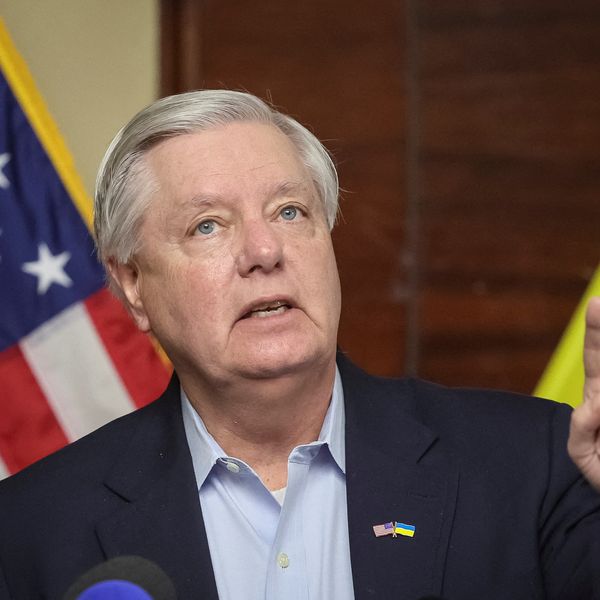In a closed-door meeting on July 23, the Senate Armed Services Committee approved a bill that would add a massive $25 billion to President Biden’s already inflated Pentagon spending request of $715 billion. The 25-to-1 vote, “an utter blowout,” is the clearest sign yet of growing bipartisan consensus for increasing the money spent on weapons and war.
This boost stands in sharp contrast to the defense spending bill recently reported by the House Appropriations Committee, which recommended a slightly lower total than the president’s initial request ($705.9 billion). The pressure is now back on the House to either stand its ground on a lower topline number or accede to pressure from Pentagon brass and military contractors. Given virtually unanimous Senate vote, even Democrats appear unwilling to impose any kind of fiscal discipline on the Pentagon.
Although top military leaders at the Pentagon, namely Defense Secretary Lloyd Austin and Joint Chiefs of Staff Chairman Gen. Mark Milley, attempted to reassure members of the House Armed Services Committee that the president’s request was enough to respond to emerging threats, they were outgunned by the service chiefs, who convinced the Senate Armed Services Committee to go along with their multibillion dollar wish lists.
Spending for deterrence or dominance?
Progressives have been hopeful that Democratic control of the White House and both houses of Congress would offer an opportunity to reverse course from the military spending that skyrocketed under President Trump. They were encouraged by several powerful Democrats who signaled interest in ways to change the status quo. In 2020, 23 Democratic and independent senators, including then-Minority Leader Chuck Schumer (D-N.Y.), voted in favor of cutting the Pentagon budget by 10 percent. In April of 2021, Rep. Adam Smith (D-Wash.), Chair of the House Armed Services Committee, said that the U.S. government should abandon its model of global dominance because pursuing that unrealizable goal is making the country less safe. “Rather than seeking to dominate all its adversaries, the U.S. military should look for ways to change their calculus, to make it clear that conflict was not in their interests. ‘Deterrence, not dominance,’ is what I’m really kind of looking at us being able to do here,” Smith said.
That framing has been flipped on its head by Republicans who have doubled down on the dominance model. During a June 29 House Armed Services hearing, Rep. Liz Cheney (R-Wyo.) questioned whether Biden’s budget could “maintain tenuous overmatch.”
“I come back to the notion that deterrence fundamentally requires that our adversaries understand we have the capability and the will — and that’s the military capability and the will… it seems pretty clear that being able to depend upon overmatch, being able to depend on dominance across every domain, isn’t where we’re headed with this [President Biden’s] budget,” she said.
The distinction between the two interpretations of deterrence is important. One perspective is that deterrence requires only the minimum force potential needed to convince an enemy that an attack would result in unacceptable consequences. Anything more can be considered wasteful overkill, and the budget, along with related posturing, would eliminate anything that isn’t vital.
The dominance model of deterrence, on the other hand, doesn’t have an upward ceiling. If deterrence requires having more destructive power than everyone else – and perhaps than all potential adversaries combined – then every weapons system, every piece of equipment, every aspect of military infrastructure and manufacturing could be considered vital. Indeed, this is where much of the conversations about “integrated deterrence” is going. The ability to label every nuclear weapons system as crucial to deterrence has been wildly successful at convincing policymakers to be suspicious of efforts to cut nuclear weapons systems or make changes to the U.S. nuclear posture. Any proposed alteration from the status quo has been defined by dominance model supporters as unilateral disarmament. If deterrence requires unchallenged dominance, then to question any military spending will be perceived as weakness and contrary to U.S. national security interests.
This is the core of the problem for advocates who are pushing to reduce the pattern of non-stop increases to the Pentagon budget. It doesn’t matter if the Pentagon can’t pass an audit, because even when it fails, it gets rewarded with more funding than the previous year. Every defense-related request is vital in the eyes of the Department of Defense, so lawmakers are hesitant to provide significant oversight for fear of being painted as weak on defense or unsupportive of the military.
Rejecting the dominance model
The foreign policy elite’s attachment to the global dominance model has not produced stability. Instead, it has resulted in endless wars, trillions in unnecessary military spending, massive increases in greenhouse gas emissions, and incalculable human harm. Presidents have abandoned arms control treaties, Congress has consistently rubber-stamped Pentagon spending, and yet tensions between nuclear-armed nations have reached new heights.
In this new era of strategic competition, efforts to invest in risk reduction, crisis avoidance, strategic cooperation and arms control are far more important for keeping Americans safe than continued investment in weapons and war.
Though military challenges exist, we must ensure we avoid overreacting. As Eric Gomez of the Cato Institute points out:
“Avoiding panic is not the same as encouraging complacency. The US-China relationship is rapidly deteriorating, which raises the relative risk of conflict even if that risk remains low in absolute terms. This creates a worrying cycle. As the relationship gets worse, the risk of conflict increases as does the need to find diplomatic ways to reduce nuclear danger, but deepening political distrust makes such negotiations harder to start… responding to China’s nuclear arsenal changes with more spending on US nuclear forces or a purely competitive approach that leaves no room for diplomacy would be a mistake.”
Despite increased tensions, President Biden has stated his Interim National Security Strategic Guidance that he intends to reduce the role of nuclear weapons in national security strategy. Both President Biden and Russian President Vladimir Putin have reaffirmed Ronald Reagan’s dictum that nuclear war can never be won and must never be fought and have begun arms control talks to build upon previous agreements. These developments offer hope that the United States can reach agreements with even its staunchest adversaries, pulling back from the brink of war and breaking the cycles of mistrust. Any war, hot or cold, is a choice that should not be accepted as inevitable.














